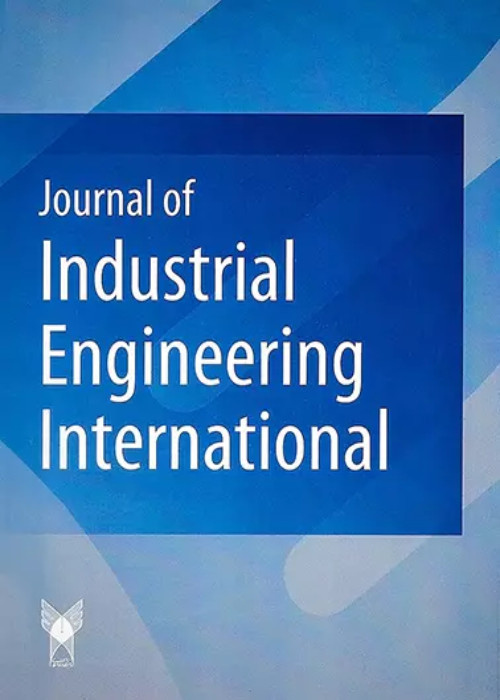فهرست مطالب
Journal Of Industrial Engineering International
Volume:3 Issue: 2, jul 2007
- تاریخ انتشار: 1386/10/11
- تعداد عناوین: 7
-
-
Page 1
In the portfolio selection problem, the manager considers several objectives simultaneously such as the rate of return, the liquidity and the risk of portfolios. These objectives are conflicting and incommensurable. Moreover, the objectives can be imprecise. Generally, the portfolio manager seeks the best combination of the stocks that meets his investment objectives. The imprecise Goal Programming model will be utilized to build the most satisfactory portfolio. The concept of satisfaction functions will be utilized to integrate explicitly the preferences of the portfolio’s manager. The developed model has been applied to portfolio selection within the Tunisian stock exchange market.
Keywords: Portfolio selection, Imprecise goal programming, Satisfaction function, Manager’s preferences -
Page 9
Representation and modeling of economic uncertainty is addressed by different modeling methods, namely stochastic variables and probabilities, interval analysis, and fuzzy numbers, in particular triple estimates. Fo-cusing on discounted cash flow analysis numerical results are presented, comparisons are made between alter-native modeling methods, and characteristics of the methods are discussed.
Keywords: Economic uncertainty, Modeling, Stochastic, Probability, Interval, Fuzzy number, Triple estimate, Discounted cash flow -
Page 19
The goal of this paper is to show how the concept of fuzzy logic can be used to establish a degree to which an investment project belongs to a class of risk. Also, the probability of the fuzzy event is presented and is ap-plied to calculate the probability of the fuzzy event “the project X is a good investment”. This process has to enable the decision maker to compare several alternative investments from the fuzzy logic perspective and, in this way, allows him to include the uncertainty that comes with the problem in reality. Moreover, by experi-ments with the proposed fuzzy model the user can obtain new knowledge for investment risk analysis.
Keywords: Fuzzy numbers, Fuzzy logic, Fuzzy probability, Risk analysis -
Page 27
The Robust Coloring Problem (RCP) is a generalization of the well-known Graph Coloring Problem where we seek for a solution that remains valid when extra edges are added. The RCP is used in scheduling of events with possible last-minute changes and study frequency assignments of the electromagnetic spectrum. This problem has been proved as NP-hard and in instances larger than 30 vertices, meta-heuristics are required. In this paper a Simulated Annealing Algorithm is proposed, and his performance is compared against other tech-niques such as GRASP, Tabu Search and Scatter Search. In the classic instances of the problem our proposal method which gives the best solutions at this moment.
Keywords: Robust coloring problem, Graph coloring, Heuristics, Simulated Annealing -
Page 33
Based on the point of view of geometrical representation of an intuitionistic fuzzy set, we take into account all three parameters describing intuitionistic fuzzy set, propose a kind of new method to calculate correlation and correlation coefficient of intuitionistic fuzzy sets which is similar to the cosine of the intersectional angle in finite sets and probability space, respectively. Further, we discuss some of their properties and give three numerical examples to illustrate our proposed method reasonable.
Keywords: Intuitionistic fuzzy set, Fuzzy set, Correlation, Correlation coefficient -
Page 41
Human factors are among the main elements affecting the reliability of nondestructive examinations (NDE). In a man-machine system, human reliability is affected by many factors (performance shaping factors) whose influence on reliability cannot be easily expressed quantitatively. This paper identifies and ranks 59 perform-ance shaping factors by using a fuzzy reasoning method and proposes a procedure to measure them. This will determine the Quality Standard (QS) for a NDE system so that human reliability in ultrasonic nondestructive examinations can be qualitatively evaluated.
Keywords: Human reliability, Ultrasonic nondestructive examinations, Fuzzy sets, Human factors, Performance shaping factors -
Page 53
This paper investigates the performances of artificial neural networks approximation, the Translog and the Fourier flexible functional forms for the cost function, when different production technologies are used. Using simulated data bases, the author provides a comparison in terms of capability to reproduce input demands and in terms of the corresponding input elasticities of substitution estimates. The results suggest that ANN provide a better approximation than other traditional functional forms only when a single technology is used. However, when elasticities of substitution are calculated, the Translog approximate batters the true technology in both single and mixed technology.
Keywords: Artificial neural networks, Cost function, Flexible functional forms


